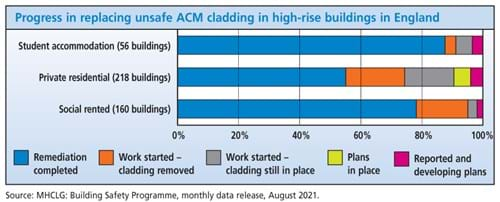04 Nov 2021
Fire safety four years after the Grenfell Tower fire
In the aftermath of the Grenfell Tower disaster, the government focused its safety efforts on replacing ACM cladding (aluminium composite material) implicated in the fire. Even so, four years later, progress is still slow. In the social sector, 78 per cent of buildings affected have had remedial work completed but in the private sector the figure is only 55 per cent (see chart). Some 75, mainly private, buildings are likely to have works outstanding at the end of 2021, despite the government originally expecting all works to be finished by 2020.

Progress in replacing unsafe ACM cladding in high-rise buildings in England
Source: MHCLG Building Safety Programme, monthly data release, August 2021.
The case of a fire in a 19-storey private block in Poplar, London, where ACM remedial work is in progress, is a reminder of those remaining problems. The fire, unrelated to the cladding, spread quickly despite a ‘waking watch’ scheme; smoke detectors failed, some fire doors did not close and ventilation shafts failed to open; fire escapes filled with smoke while 42 people were being evacuated. Leaseholders in the same scheme remain liable for £3.1 million of the £11.6 million cost to remedy the faults.
To tackle safety problems in the large number of buildings with other unsafe cladding materials such as high-pressure laminates, owners can bid for grants from a £5 billion government fund. Grants are available only for buildings above 18m in height. For lower buildings, loan (not grant) funding towards the cost of works is promised, but details are awaited, including how to resolve the tricky issue of who takes on the loans. Last month’s Budget confirmed that a 4 per cent cladding tax would pay for the scheme.
In buildings at risk, waking watch schemes are eligible for help from a separate £35 million fund, expected to assist residents in up to 480 buildings. By August, 178 applications had been approved. However, fire chiefs told the GLA that there are now 901 buildings with waking watches in London alone, many receiving no government help. Some 21 per cent of residents in high-rise blocks in England currently feel ‘unsafe’ from fire, according to the English Housing Survey.
The full extent of non-ACM structural fire safety problems is unknown. England has 12,000 high-rise residential buildings (over 18m in height), with another 76,000 medium-rise buildings (11-18m tall). Originally, 1,700 of the high-rise group were considered to be at risk, but this figure is now in doubt and the number at risk in the medium-rise group is unknown. Inside Housing suggests the true total for people at risk across the UK in both high-rise and medium-rise buildings could be well over one million.
What might be the total cost of remedial work? In 2020 the Commons Housing, Communities and Local Government Committee estimated that it might be £15 billion for high-rise buildings alone; a year later, it is still urging the government to produce equivalent data on progress in tackling the problems as it does for the more limited issue of ACM cladding. So far, the government will only reveal how many applications for funding it has received.
Fire risk is only part of the problem. Others surround the requirement for building safety assessments, including massive delays in securing the required surveys; unclear responsibility as to who pays for them; how to respond when (in most cases) fire safety works are required for mortgage purposes, and the implications for building insurance. An estimated 1.5 million flat owners have found themselves trapped in properties that are unsaleable until these problems are addressed.
The campaign group, End Our Cladding Scandal, has put forward a ten-point plan which includes fully funding social landlords to do remedial work and providing up-front finance to private owners. For the latter, the aim would be to recover costs afterwards ‘from those who are at fault or took the profits for building and selling these properties’. Given that this is an issue which hits homeowners hard, and daily risks producing another tragedy, perhaps the most damning aspect of the crisis is how slowly and haphazardly the government is tackling it.
This article is based on one for the CIH’s UK Housing Review. You can download the 2021 UK Housing Review Autumn Briefing Paper.


